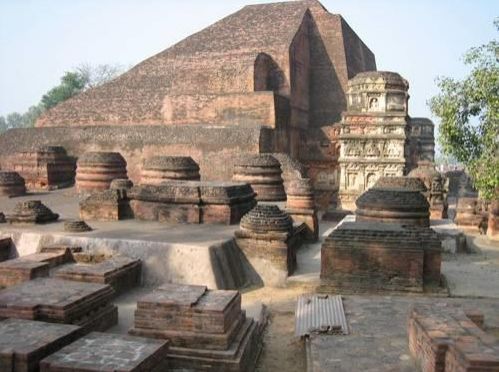................................................................................................................................................................................................................................................................................................................................................................................................................................................................................................................
Nalanda

Copyright © visitindia.org.in. All Rights Reserved.
Nalanda is an ancient center of higher learning in Bihar, India from 427 to 1197. Nalanda was established in the 5th century AD in Bihar, India. Founded in 427 in northeastern India, not far from what is today the southern border of Nepal, it survived until 1197. It was devoted to Buddhist studies, but it also trained students in fine arts, medicine, mathematics, astronomy, politics and the art of war.
The center had eight separate compounds, 10 temples, meditation halls, classrooms, lakes and parks. It had a nine-story library where monks meticulously copied books and documents so that individual scholars could have their own collections. It had dormitories for students, perhaps a first for an educational institution, housing 10,000 students in the university’s heyday and providing accommodations for 2,000 professors. Nalanda University attracted pupils and scholars from Korea, Japan, China, Tibet, Indonesia, Persia and Turkey.
Best time to visit Nalanda
October to March is the best season to visit Nalanda.

Travelogues/Travel Logs of Roadtrips
Hit the road with the summary guides of our trips to various places in India. Any information feel free to drop a mail at info@visitindia.org.in


Get online driving directions, route guides, weekend planners, and customised itineries. Check out a few of our favorite user road trips, then start an adventure of your own.....Explore India by Road

Find us :-
How to reach Nalanda
By Air : The nearest airport from Nalanda is Patna which is about around 89 km away
By Rail : Rajgir is the nearest railway station from Nalanda is 12 km away.
By Road : Nalanda is connected by a good road network with Rajgir 12 Km, Bodh Gaya 50 Km, Gaya 65 Km, Patna 90 Km, Pawapuri 26 Km, and Bihar Sharif 13 Km.



A half hour bus ride from Rajgir is Nalanda, the site of the world's first University. Although the site was a pilgrimage destination from the 1st Century A.D., it has a link with the Buddha as he often came here and two of his chief disciples, Sariputra and Moggallana, came from this area. The large stupa is known as Sariputra's Stupa, marking the spot not only where his relics are entombed, but where he was supposedly born.
The site has a number of small monasteries where the monks lived and studied and many of them were rebuilt over the centuries. We were told that one of the cells belonged to Naropa, who was instrumental in bringing Buddism to Tibet, along with such Nalanda luminaries as Shantirakshita and Padmasambhava. A small opening in the cell revealed a tiny room where Naropa supposedly meditated.
Nalanda's main importance comes from its Buddhist roots as a center of learning. Hsuan Tsang, the famous pilgrim from China came here and studied and taught for 5 years in the 7th Century A.D. Nalanda University at that time had over 10,000 students and 3,000 teachers. For some 700 years, between the 5th and 12th Centuries, Nalanda was the center of scholarship and Buddhist studies in the ancient world. A great fire wiped out the library of over 9 million manuscripts and at the beginning of the 12th Century, the Muslim invader Bakhtiyar Khalji sacked the university.
It was in the 1860's that the great archeologist Alexander Cunningham identified the site as the Nalanda University and in 1915-1916 the Archeological Survey of India began excavations of the site. What has been excavated to date is only a small part of the entire site but much of the ruins are beneath existing villages and are unlikely to be revealed. The present site is well-maintained and very pleasant to visit.
Across the street is the small museum with some excellent Buddhist statues and about a kilometer away is a temple dedicated to Hsuan Tsang. Nearby are the International Centre for Buddhist Studies and the Nava Nalanda Mahivihara, set up for the research of Buddhism.

Nalanda Archaeological Museum
Opposite the entrance to the ruins of the university and houses, there is a small but beautiful collection of Buddhist and Hindu bronzes and a number of undamaged statues of the Lord Buddha that were found in the area. Two enormous terra-cotta jars of the first century stand intact behind the museum in a shaded enclosure. The collection includes copper plates and stone inscriptions, coins, pottery and samples of burnt rice (12th century AD) found among the ruins here. Open during 10.00 to 17.00. Closed on Friday.
Nava Nalanda Mahavihara
Nava Nalanda Mahavihara is devoted to study and research of Pali Literature and Buddhism. This is a new institute, where students from foreign countries also study.
Hieun Tsang Memorial Hall
A new construction in memory of the great Chinese traveler, Hieun Tsang.
Griddhakoot Hill
On the side of the peak of this hill, facing northwest, are two small natural caves. They are approached over a flight of stone steps. Inside one of the caves were found a number of terracotta plaques with the seven Past Buddha and Maitreya, the future Buddha seated in two rows and the Buddhist creed inscribed below each figure in minute characters. Outside the caves are large stonewalls of structures that once existed at this place. It is said to be the hallowed site of Buddha’s habitation and meditation and has been, therefore, held especially sacred by the Buddhists.
Bimbisara Jail
It is situated about half a kilometer southeast of Maniyar Math, inside the limits of the ancient inner city. These ruins are of great antiquity. It is believed that when his son Ajatshatru imprisoned king Bimbisara, he was able to see Buddha on the Griddhakoot hill.
Maniyar Math
This monument occupies a prominent position inside the valley, situated almost in the center of the enclosure of the ancient inner city, on the way to the Son Bhandar Caves. Legend is that Srenika or Bimbisara had 32 wives to each of which he daily gave new ornaments, and threw the old ones into a well, which is still shown. A small temple of the Jain, quite modern, covers this well.
Jarasandh Ki Baithak / Pippala Cave
On the ascent to the top of the hill from the hot springs is seen a large stone structure. It is associated with the primeval King of Rajgir, Jarasandha. It is said that the king had his baithak or open sit-out here. The tradition, as quoted by Fa Hian, says that there was the Pippala Cave here where Buddha used to sit in deep meditation after his
mid-day meal.
Sataparni Cave
On the northern cave of the Vaibhara hill, a little below the old Jain temple of Adinatha, is a series of six caves contained in a natural bend of rock. These caves, with the large terrace in front, are now generally believed to be the site where the First Buddhist Council was held a few months after Buddha’s death during the reign of King
Ajastshatru.
Ajastshatru Stupa
To the east of the Venuvan area, close by the side of the road on its east are the ruins of a stone structure, built in the fashion of Pippala cave. The site occupies a very prominent situation on the road from the modern Rajgir town to the hot- springs.
The Fortification Walls
Walls, called as inner-fortification walls, protected the ancient town of Rajagriha. Traces of fortification wall are noticed on the tops of the hills at Rajgir.
What to see around Nalanda
Silao
In between Nalanda and Rajgir, there is a village namely Silao where very a popular local sweet "KHAJA" is prepared.
Surajpur Baragaon
The lake with its temple of Surya, the Sun God , is a pilgrim destination twice a year in "Vaishakha" (April-May) and in "Kartika" (October-November) during the Chhath Puja or Sun worship.

Excursions around Nalanda
Rajgir 15 kms
The ancient capital of Magadhan empire which flourished in the 6th century BC. Its association with Lord Buddha and Lord Mahavira hallows the place. The first Buddhist council immediately after the Mahaparinirarvana of Lord Buddha , to pen down his teachings , was also held at Rajgir. There are a number of Hot Springs. The hill town of Rajgir, surrounded by seven hills is in the midst of lush green forest.
Pawapuri 25km
A sinless city it is a great pilgrimage center of the Jains. Lord Mahavira, the greatest propounder of Jainism had delivered his last sermon took Mahaparinirvana and was cremated here. Jalmandir and Samosharan are two beautiful temples here of exquisite architecture built in white marble.
